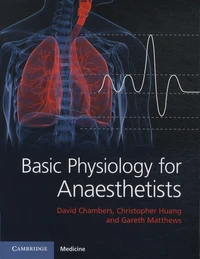Basic Physiology for Anaesthetists
2nd edition
Par : , , Formats :
Définitivement indisponible
Cet article ne peut plus être commandé sur notre site (ouvrage épuisé ou plus commercialisé). Il se peut néanmoins que l'éditeur imprime une nouvelle édition de cet ouvrage à l'avenir. Nous vous invitons donc à revenir périodiquement sur notre site.
- Paiement en ligne :
- Livraison à domicile ou en point Mondial Relay indisponible
- Retrait Click and Collect en magasin gratuit
- Réservation en ligne avec paiement en magasin :
- Indisponible pour réserver et payer en magasin
- Nombre de pages452
- PrésentationBroché
- FormatGrand Format
- Poids1.012 kg
- Dimensions18,9 cm × 24,4 cm × 2,5 cm
- ISBN978-1-108-46399-7
- EAN9781108463997
- Date de parution25/07/2019
- ÉditeurCambridge University Press
Résumé
Every trainee in anaesthesia requires a thorough understanding of basic physiology and its application to clinical practice. Now in its second edition, this comprehensively illustrated textbook bridges the gap between medical school and reference scientific texts. It covers the physiology requirements of the Primary FRCA examination syllabus. Chapters are organised by organ system, with particular emphasis given to the respiratory, cardiovascular and nervous systems.
The practical question-and-answer format helps the reader prepare for oral examinations, while 'clinical reference' boxes translate the physiological concepts to clinical practice. This new edition has been thoroughly updated and revised throughout, and includes six new chapters including the physiology of the eye, upper airway and exercise testing. This book provides junior anaesthetists with an essential 'one stop' physiology resource.
The practical question-and-answer format helps the reader prepare for oral examinations, while 'clinical reference' boxes translate the physiological concepts to clinical practice. This new edition has been thoroughly updated and revised throughout, and includes six new chapters including the physiology of the eye, upper airway and exercise testing. This book provides junior anaesthetists with an essential 'one stop' physiology resource.
Every trainee in anaesthesia requires a thorough understanding of basic physiology and its application to clinical practice. Now in its second edition, this comprehensively illustrated textbook bridges the gap between medical school and reference scientific texts. It covers the physiology requirements of the Primary FRCA examination syllabus. Chapters are organised by organ system, with particular emphasis given to the respiratory, cardiovascular and nervous systems.
The practical question-and-answer format helps the reader prepare for oral examinations, while 'clinical reference' boxes translate the physiological concepts to clinical practice. This new edition has been thoroughly updated and revised throughout, and includes six new chapters including the physiology of the eye, upper airway and exercise testing. This book provides junior anaesthetists with an essential 'one stop' physiology resource.
The practical question-and-answer format helps the reader prepare for oral examinations, while 'clinical reference' boxes translate the physiological concepts to clinical practice. This new edition has been thoroughly updated and revised throughout, and includes six new chapters including the physiology of the eye, upper airway and exercise testing. This book provides junior anaesthetists with an essential 'one stop' physiology resource.



